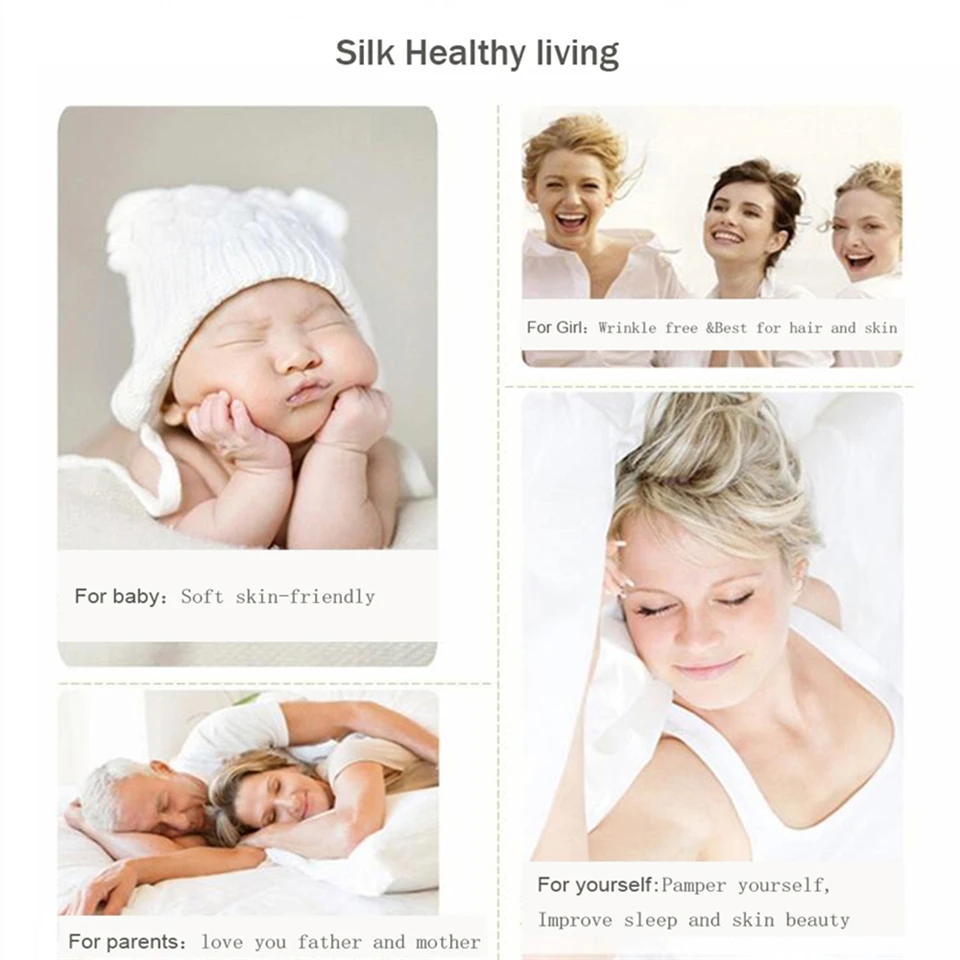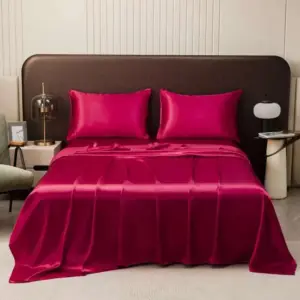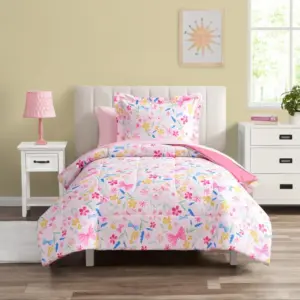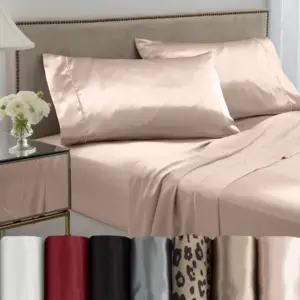Introduction
In recent years, natural luxury fabrics have surged in popularity as more consumers seek comfortable, sustainable alternatives for their bedding and clothing. The global market for premium natural fabrics has grown by nearly 15% annually, reflecting this shift toward quality and eco-consciousness in our textile choices.
When shopping for premium bedding or clothing, two natural fabrics often stand out: bamboo and mulberry silk. But which one truly delivers the best experience for your specific needs? Understanding the differences between these fabrics is essential for making informed decisions about products you’ll use every day.
In this comprehensive guide, we’ll explore:
- The unique properties that define bamboo and mulberry silk fabrics
- How they compare in comfort, durability, and sustainability
- Which fabric might better suit your specific needs and preferences
- Care requirements to maximize your investment
At Sanctuary Soft, our expertise in natural silk vs. alternative fabrics has shown us that the right fabric choice can transform ordinary sleep into extraordinary luxury. Whether you’re interested in the amazing benefits of mulberry silk sheets or curious about vegan silk bedding options, this guide will help you make the perfect choice for your lifestyle.
What is Bamboo Fabric?
Bamboo fabric is a textile derived from the pulp of bamboo plants. This versatile material has gained popularity as a sustainable alternative to traditional fabrics, including cotton and silk. The result is a surprisingly soft material with impressive performance characteristics.
There are two main production methods for bamboo fabric:
- Bamboo Viscose/Rayon: The most common form, created through a chemical process that breaks down bamboo pulp into a viscous solution before spinning it into fibers.
- Bamboo Lyocell: A more eco-friendly method using closed-loop processing systems that recycle water and solvents, reducing environmental impact.
As a source material, bamboo offers exceptional renewable qualities:
- Grows incredibly fast (up to 3 feet per day for some species)
- Requires minimal water and no pesticides
- Regenerates from its own roots without replanting
- Produces 35% more oxygen than equivalent tree masses
The resulting fabric possesses natural antibacterial properties, excellent moisture-wicking ability, and remarkable softness that many compare to cashmere. For those interested in vegan alternatives to mulberry silk, bamboo fabric represents one of the most luxurious options available. Our collection of bamboo silk sheets demonstrates how this remarkable material has evolved into a premium bedding option.
What is Mulberry Silk Fabric?
Mulberry silk is widely considered the finest and most desirable silk in the world. This premium fabric is produced exclusively from silkworms (Bombyx mori) that feed solely on the leaves of the mulberry tree. The process of creating mulberry silk has remained largely unchanged for thousands of years:
- Silkworms consume mulberry leaves and spin cocoons made of raw silk thread
- These cocoons are carefully harvested and processed
- Single strands are unwound and combined to create silk thread
- The threads are woven into the luxurious fabric we know as mulberry silk
The quality of mulberry silk is measured in momme weight (similar to thread count), typically ranging from 19-25 momme for premium products. Higher momme weights indicate denser, more durable silk with enhanced properties.
Dating back over 5,000 years to ancient China, mulberry silk has historically been reserved for royalty and the elite. Its unparalleled smoothness, natural protein structure, and distinctive sheen make it instantly recognizable as a luxury material.
For a deeper understanding of this exceptional fabric, our complete guide to mulberry silk bed sheets provides comprehensive information. Those interested in quality indicators should explore how understanding momme weight affects silk performance. Browse our collection of mulberry silk sheets to experience the difference firsthand.
Detailed Comparison: Bamboo vs. Mulberry Silk
Texture and Feel
Bamboo fabric offers an exceptionally soft and smooth texture that many describe as comparable to cashmere or high-quality cotton. Its fibers create a fabric with:
- A gentle, almost buttery softness that improves with washing
- A surprisingly lightweight feel despite its substantial drape
- A smooth surface that feels cool and comfortable against skin
- A subtle softness that’s immediately noticeable but not slippery
Mulberry silk, by contrast, provides a truly unique tactile experience that’s difficult to replicate:
- An unmistakable smoothness that allows it to glide effortlessly across skin
- A cool-to-the-touch initial sensation
- A distinctive lightweight feel with natural elasticity
- A luxurious drape that follows body contours perfectly
Textile experts often note that while bamboo fabric provides exceptional softness, the unique properties of mulberry silk create an unmatched sensory experience. This is particularly evident in items like mulberry silk pillowcases, where direct skin contact highlights these textural differences.
Breathability and Temperature Regulation
Both fabrics excel at temperature regulation, but they achieve this comfort in different ways.
Bamboo fabric features:
* Natural micro-gaps in its fiber structure that allow heat to escape
* Superior moisture-wicking that draws sweat away from the body
* Excellent ventilation that prevents overheating
* Thermal-regulating properties that work in both warm and cool conditions
Mulberry silk offers:
* Natural protein fibers that adjust to body temperature
* The ability to create a microclimate that insulates in winter and cools in summer
* Remarkable temperature-stabilizing properties despite its lightweight nature
* Moisture control that prevents the clammy feeling often associated with sweating
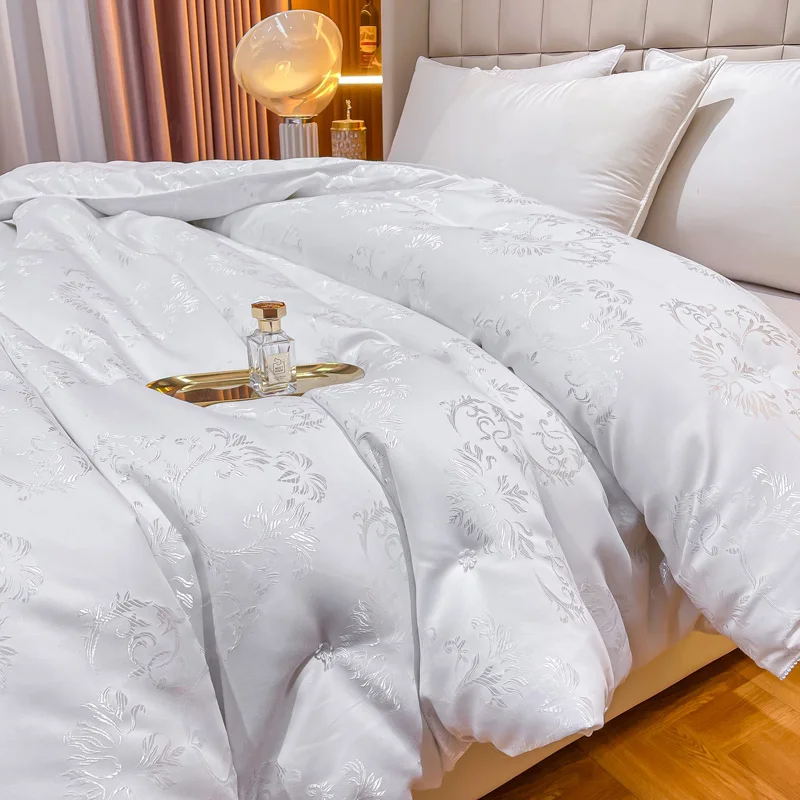
These breathability features directly impact sleep quality, as proper temperature regulation is essential for uninterrupted rest. For those struggling with sleep issues, understanding how these fabrics can transform sleep quality is invaluable. Our collection of cooling silk sheets showcases how these temperature-regulating properties translate to better sleep experiences.
Durability and Longevity
When comparing investment value, durability becomes a crucial factor:
| Fabric Type | Average Lifespan | Common Wear Issues | Washing Resilience |
|---|---|---|---|
| Bamboo | 5-8 years | Potential pilling over time, may lose softness with improper washing | Moderately resilient, can withstand regular machine washing with proper care |
| Mulberry Silk | 10-15+ years | Potential weakening if exposed to harsh chemicals, susceptible to snags | Requires gentle washing, maintains integrity with proper care for decades |
Bamboo fabric offers impressive durability for its softness, resisting pilling better than many cotton alternatives. However, lower-quality bamboo rayon can deteriorate faster if subjected to harsh detergents or high-heat drying.
Mulberry silk’s natural protein structure creates one of the strongest natural fibers available, with exceptional tensile strength. With proper care, high-quality silk items can become family heirlooms. Understanding how to properly measure silk quality is essential for maximizing this durability advantage.
Hypoallergenic Properties and Skin Benefits
For those with sensitive skin or allergies, fabric choice becomes particularly important:
Bamboo fabric offers:
* Natural antibacterial properties that reduce odor-causing bacteria
* Hypoallergenic fibers that rarely trigger allergic reactions
* Smooth surfaces that minimize friction against skin
* Moisture management that reduces bacteria growth
Mulberry silk provides:
* Natural protein structure containing amino acids that benefit skin
* Exceptionally smooth surface that reduces friction on skin and hair
* Hypoallergenic properties that resist dust mites and other allergens
* Natural temperature regulation that prevents overheating and night sweats
These properties explain why dermatologists often recommend silk for patients with sensitive skin conditions like eczema or rosacea. The mulberry silk bedding skin benefits are particularly notable for facial skin, as mulberry silk sheets for sensitive skin can reduce irritation overnight. Our silk pillowcases are specifically designed to maximize these skin-friendly properties.
Moisture Management
How a fabric handles moisture significantly impacts comfort, especially during sleep:
Bamboo fabric excels with:
* Superior absorption capacity (absorbs up to 40% more water than cotton)
* Exceptional wicking action that pulls moisture away from the skin
* Quick-drying properties that prevent dampness
* Antibacterial properties that inhibit odor even when moist
Mulberry silk manages moisture through:
* Efficient absorption of moisture without feeling wet (can absorb up to 30% of its weight)
* Natural temperature regulation that reduces sweating
* Protein structure that wicks moisture away from skin
* Breathability that allows moisture to evaporate quickly
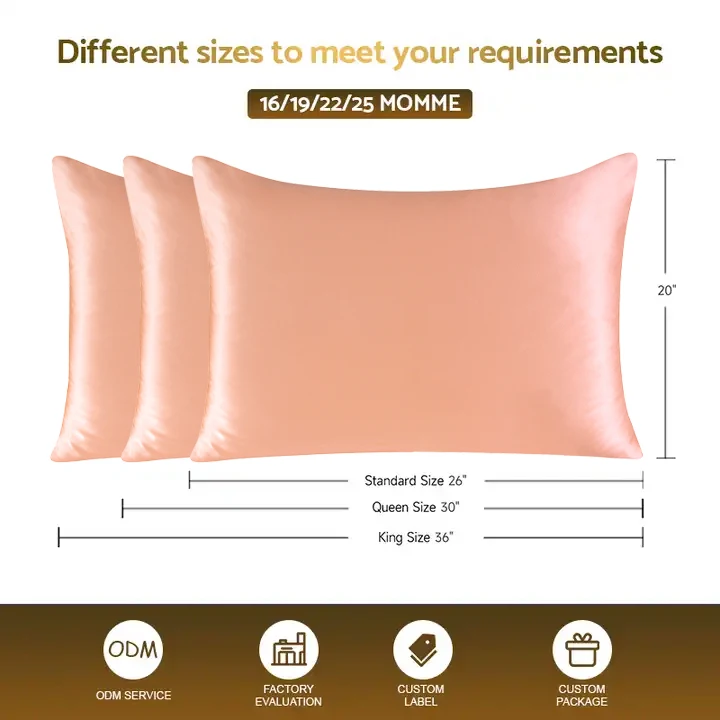
The molecular structure of each fiber determines these moisture-handling properties. Bamboo’s hollow fiber structure creates micro-gaps that channel moisture away, while silk’s protein structure allows it to absorb moisture without feeling damp against the skin.
Visual Appeal and Luster
The aesthetic qualities of these fabrics contribute significantly to their luxury appeal:
Bamboo fabric features:
* A subtle, gentle sheen that’s noticeable but understated
* A smooth surface that reflects light evenly
* A modern, sophisticated appearance
* Excellent color retention that maintains appearance after washing
Mulberry silk is renowned for:
* A distinctive, luminous sheen that naturally reflects light
* A multi-dimensional luster that changes with movement
* A timeless elegance associated with luxury
* A unique way of catching light that creates depth in colors
This visual distinction is particularly evident in luxury silk bedding sets, where the play of light across silk’s surface creates a distinctive ambiance that bamboo, despite its own beauty, cannot fully replicate.
Care Requirements and Maintenance
Proper care significantly impacts the longevity of both fabrics:
| Care Aspect | Bamboo Fabric | Mulberry Silk |
|---|---|---|
| Washing | Machine washable on gentle/cold cycle | Hand wash or delicate machine cycle with silk-specific detergent |
| Drying | Low heat or air dry | Air dry only, away from direct sunlight |
| Ironing | Low heat if necessary | Very low heat with barrier cloth if necessary |
| Storage | Normal folding acceptable | Should be stored flat or loosely folded to prevent creasing |
| Common Mistakes | Using bleach, fabric softeners, hot water | Using regular detergents, wringing out when wet, direct sunlight exposure |
Bamboo fabric generally requires less specialized care, making it more convenient for everyday use. However, the extra care needed for silk pays off in its exceptional longevity and maintained properties over time.
Cost Comparison and Value Assessment
When comparing these premium fabrics, initial cost is just one factor in total value:
| Product Type | Bamboo Price Range | Mulberry Silk Price Range |
|---|---|---|
| Sheet Sets | Moderate-High | High-Premium |
| Pillowcases | Moderate | Moderate-High |
| Clothing Items | Moderate | High-Premium |
While bamboo typically costs less initially, several factors should influence your value assessment:
- Mulberry silk’s significantly longer lifespan (often 2-3 times longer)
- Silk’s unique properties that cannot be fully replicated
- The specialized skin and hair benefits of silk
- Bamboo’s easier care requirements and lower maintenance costs
The true value depends on your personal priorities—immediate affordability versus long-term investment, ease of care versus specialized properties.
Environmental and Ethical Considerations
Sustainability Profile: Bamboo
Bamboo as a raw material offers impressive environmental credentials:
- Renewable resource that grows rapidly (up to 3 feet daily for some species)
- Requires minimal water and no pesticides
- Produces 35% more oxygen than equivalent tree masses
- Helps prevent soil erosion with its extensive root system
However, the processing methods significantly impact its overall sustainability:
- Bamboo viscose/rayon uses chemical processes with potential environmental impacts
- Bamboo lyocell employs closed-loop systems that recapture and reuse chemicals
- Water usage varies dramatically between processing methods
- Most bamboo fabric is biodegradable at end-of-life
For those prioritizing environmental impact, exploring environmentally friendly silk fabrics alongside options like our bamboo silk bedding sets can help make informed decisions.
Sustainability Profile: Mulberry Silk
Mulberry silk offers a complex sustainability profile:
- Natural, biodegradable protein fiber
- Traditional sericulture requires mulberry trees which support ecosystem diversity
- Renewable resource that requires minimal processing chemicals compared to synthetic fabrics
- Lower water usage than many other natural fibers
Traditional silk production does raise ethical considerations regarding silkworm harvesting. For those concerned with this aspect, exploring whether mulberry silk is vegan-friendly provides important context. Alternative options include peace silk (allowing moths to emerge before harvesting cocoons) and various plant-based silk alternatives.
Full-size Silk Sheets, King Size Silk Sheets, Queen Size Silk Sheets, Twin Size Silk Sheets, Washable Silk Sheets
Price range: $95.95 through $178.37 Select options This product has multiple variants. The options may be chosen on the product page100% Silk Sheets, Green Silk Sheets, King Size Silk Bedding Set, Mulberry Silk Bedding Sets, Queen Size Silk Bedding Set
Price range: $1,246.21 through $1,615.22 Select options This product has multiple variants. The options may be chosen on the product pagePink Silk Sheets, Twin Size Silk Sheets
$171.80 Select options This product has multiple variants. The options may be chosen on the product pageFull-size Silk Sheets, Pink Silk Sheets
$136.31 Select options This product has multiple variants. The options may be chosen on the product pageGrey Silk Sheets, Silk Sheet and Pillowcase Set
Price range: $88.20 through $146.64 Select options This product has multiple variants. The options may be chosen on the product pageBamboo Silk Sheets, Cooling Silk Sheets
Price range: $130.76 through $177.80 Select options This product has multiple variants. The options may be chosen on the product page
Best Applications for Each Fabric
Ideal Uses for Bamboo Fabric
Bamboo fabric particularly excels in:
- Year-round bedding for hot sleepers
- Activewear and athletic clothing
- Everyday casual clothing
- Underwear and intimate apparel
- Bath towels and washcloths
- Baby clothing and bedding
The combination of moisture management, antibacterial properties, and everyday durability makes bamboo ideal for items requiring frequent use and washing. Its temperature regulation also makes it suitable for variable climates and seasons.
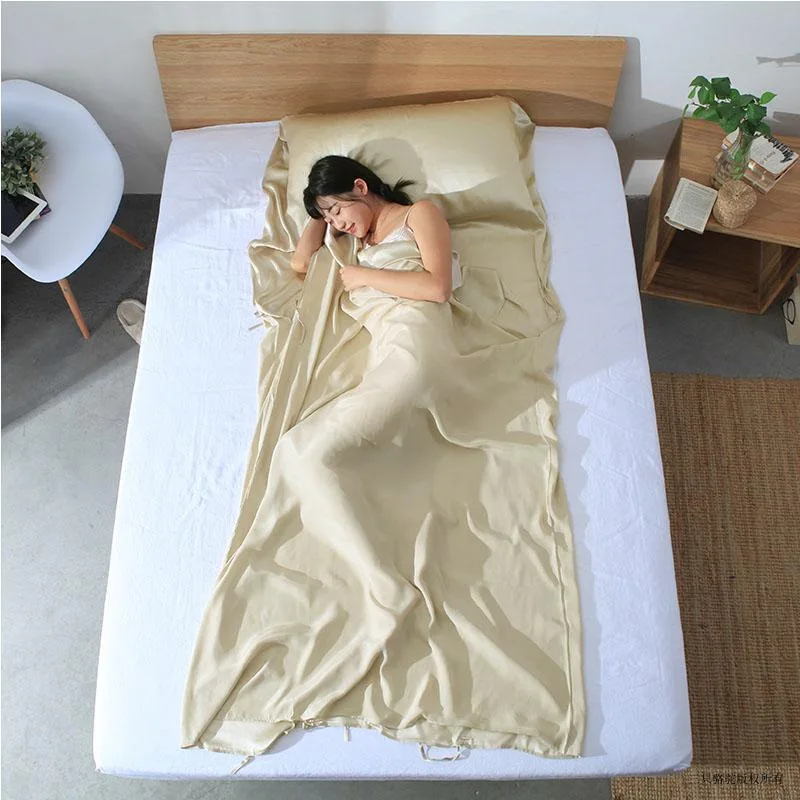
Ideal Uses for Mulberry Silk Fabric
Mulberry silk provides exceptional performance in:
- Luxury bedding, particularly pillowcases and sheets
- Hair protection accessories (sleep caps, scrunchies)
- High-end lingerie and sleepwear
- Special occasion clothing
- Accessories like scarves and wraps
- Anti-aging skin care applications
The unique combination of skin benefits, temperature regulation, and luxurious feel makes mulberry silk unmatched for applications where direct contact with skin and hair is primary. Understanding the exceptional benefits of mulberry silk sheets explains why they remain the gold standard for luxury bedding.
Making Your Decision: Who Should Choose Which Fabric?
Who Should Choose Bamboo?
Bamboo fabric is ideal for:
- Value-conscious shoppers seeking premium feel at a more accessible price point
- Those who prioritize easy care and practical maintenance
- Hot sleepers who struggle with night sweats
- Environmentally conscious consumers (especially bamboo lyocell)
- Those who want long-lasting softness with minimal special care
- People with active lifestyles who need moisture-wicking properties
Jessica, a yoga instructor, represents a perfect bamboo customer: “I need bedding that handles moisture well after my evening practice, feels gentle on my skin, and doesn’t require complicated washing procedures since I have limited time between teaching classes.”
Who Should Choose Mulberry Silk?
Mulberry silk is perfect for:
- Those seeking the ultimate luxury sleep experience
- People with sensitive skin conditions like eczema or rosacea
- Hair care enthusiasts wanting to minimize breakage and frizz
- Those viewing bedding as a long-term investment
- Gift-givers looking for premium, special occasion presents
- Anyone who prioritizes the unique benefits that only real silk can provide
Michael, an executive with sensitive skin, exemplifies the ideal silk customer: “After trying various fabrics, nothing compares to how my skin feels after sleeping on silk. The advantages of sleeping on mulberry silk have been transformative for my skin irritation issues, and I consider it a worthwhile investment in my daily comfort and appearance.”
Frequently Asked Questions
Is bamboo fabric as luxurious as mulberry silk?
While bamboo offers exceptional softness that rivals many luxury fabrics, mulberry silk provides a unique combination of smoothness, luster, and protein structure that cannot be fully replicated. Each offers a different type of luxury experience.
Which fabric is better for hot sleepers?
Both excel at temperature regulation, but bamboo typically has superior moisture-wicking properties, making it slightly better for excessive sweating. However, mulberry silk sheets still provide excellent temperature regulation for most sleepers.
Can bamboo fabric provide the same benefits for hair as silk?
While bamboo is smooth and gentle, it doesn’t match silk’s ability to reduce friction on hair. Silk’s exceptionally smooth surface and protein structure make it superior for preventing hair breakage and frizz.
How do I know if I’m buying genuine mulberry silk or bamboo fabric?
Authentic mulberry silk will specify its momme weight (typically 19-25 for quality pieces) and have a distinctive smooth feel and natural luster. Genuine bamboo should specify whether it’s bamboo viscose/rayon or the more eco-friendly lyocell process.
Which fabric is more wrinkle-resistant?
Bamboo typically wrinkles less than silk and is easier to smooth out without ironing. Silk naturally develops character creases but also releases wrinkles more readily when hung in a steamy bathroom.
What makes silk hypoallergenic?
Silk’s natural protein structure resists dust mites, mold, and mildew while its smooth surface prevents irritation—making it particularly suitable for sensitive skin and allergy sufferers.
Caring for Your Premium Fabrics
Proper care extends the life of your premium fabrics significantly:
For Bamboo Fabric:
1. Wash in cold water on a gentle cycle with mild detergent
2. Avoid bleach and fabric softeners which can break down fibers
3. Tumble dry on low or air dry for best results
4. Remove promptly from dryer to minimize wrinkles
5. Store folded in cool, dry locations
For Mulberry Silk:
1. Hand wash in cool water with specialized silk detergent
2. Never wring or twist; instead, press water out gently
3. Air dry away from direct sunlight
4. Store flat or loosely rolled to prevent permanent creasing
5. Avoid prolonged exposure to direct sunlight which can weaken fibers
For both fabrics, address stains immediately using appropriate gentle methods rather than harsh chemicals. Our collection of silk sheets includes care instructions specifically tailored to maximize their lifespan.
Conclusion: Finding Your Perfect Luxury Fabric
Both bamboo and mulberry silk offer exceptional qualities that elevate them above standard fabrics. Your perfect choice ultimately depends on your personal priorities:
Choose bamboo if you value:
* Excellent softness with easier care requirements
* Strong moisture management for hot sleepers
* More affordable luxury
* Versatility across many applications
Choose mulberry silk if you prioritize:
* The ultimate luxury experience with unique properties
* Maximum skin and hair benefits
* Long-term investment value
* Classic elegance and timeless appeal
Remember that quality matters significantly with both fabrics. A high-quality bamboo product will outperform low-quality silk, and vice versa. Whether you choose the accessible luxury of bamboo or the timeless elegance of mulberry silk, investing in premium natural fabrics always enhances your daily comfort and well-being.

